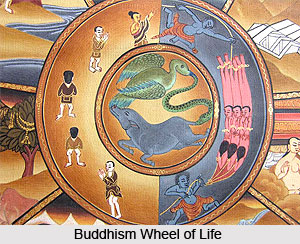 Vajrayana when correctly understood and practised can prove to be an effective antidote against phobias and fears that afflict human life. It is believed that mental afflictions such as paranoia, neurosis, schizophrenia etc are able to get a grip on man because his mind is not adamantine. The practice of the Vajra has been formulated in such a way so as to make the follower, or the yogi, adamantine and strong. In this way he is fortified against mental afflictions. He is enabled to stare at the face of every type of fear by means of the visualisation of the wrathful deities. The places that he frequents, such as uninhabited territories, make him shed all his fears. The tantric use, especially of the makaras, makes the yogi`s mind unmoved by notions such as likes and dislikes, clean and unclean, edible, inedible, worthy, and unworthy, etc., which generate fear and anxiety in the minds of the uninitiated. The Vajra method is not one of developing self-control or a stoic sense. In it there is no occasion for `control`, since afflictions do not afflict him any more; the Vajra theory and praxis take the sting out of mental afflictions, by discovering their nature as void. Hence the tantric praxis could be further explored to discover its psychic effects and be adapted to attain better mental health.
Vajrayana when correctly understood and practised can prove to be an effective antidote against phobias and fears that afflict human life. It is believed that mental afflictions such as paranoia, neurosis, schizophrenia etc are able to get a grip on man because his mind is not adamantine. The practice of the Vajra has been formulated in such a way so as to make the follower, or the yogi, adamantine and strong. In this way he is fortified against mental afflictions. He is enabled to stare at the face of every type of fear by means of the visualisation of the wrathful deities. The places that he frequents, such as uninhabited territories, make him shed all his fears. The tantric use, especially of the makaras, makes the yogi`s mind unmoved by notions such as likes and dislikes, clean and unclean, edible, inedible, worthy, and unworthy, etc., which generate fear and anxiety in the minds of the uninitiated. The Vajra method is not one of developing self-control or a stoic sense. In it there is no occasion for `control`, since afflictions do not afflict him any more; the Vajra theory and praxis take the sting out of mental afflictions, by discovering their nature as void. Hence the tantric praxis could be further explored to discover its psychic effects and be adapted to attain better mental health.
It can be said of the Vajrayana school of Buddhism that, to some extent, it has anticipated by centuries some of the discoveries of modern depth psychology and the art of psychoanalysis. These insights, though clothed in symbolic and esoteric language, are, nevertheless valid and significant. The body-soul dichotomy and conflict, inherited from the Aristotelian tradition, is put to rest by viewing man as a whole, and as a microcosm. The classic distinction between man God and the world ultimately lapses from the cosmicization of man. This vision of things is not realised through conceptual investigation of reality; it is the fruit of an experiential philosophy. Here, concepts do not remain abstract, cold and lifeless, but come alive in three-dimensional images and visions, bringing to the fore the imaginative and emotive dimensions of `doing` metaphysics.
Vajrayana opens the doors to religious freedom. Man is free to conceive God in any manner he wants as every concept is equally provisional. This has broken walls of faith and also shaken the religious traditions of the ordinary believer, as deeply rooted as he is, in one particular concept of God to the exclusion of all the rest. In Vajrayana, religion turns on itself and is turned inside out, and reveals the inner dynamics of religious enterprise. It does not deny the claims of revelation, but shows that revelation is as much human as it is divine.
As regards the problem of evil, Vajrayana has a unique understanding of it. The Vajrayanic concept of evil is such that it looks in the face of evil and embraces it. This is because evil is said to be the other side of goodness itself. Both good and evil are seen as energies available to man, and they need to be channeled to benefit him. Thus is evil is not something that needs to be conquered or condemned but converted. In this way, the entire spectrum of psychic energy in the form of good and evil, is tapped and is made use of for the benefit of man.
Thus, the use of Vajrayana in understanding various human afflictions is noteworthy. It helps in strengthening the resolve and mental durability of human beings thereby making them more resilient during times of adversity.




















